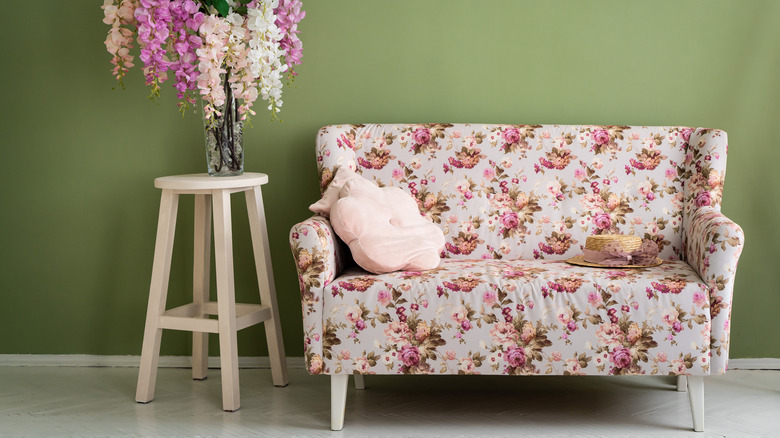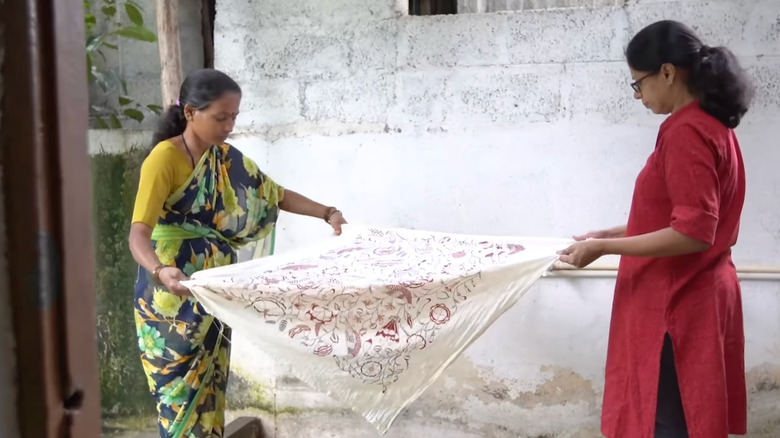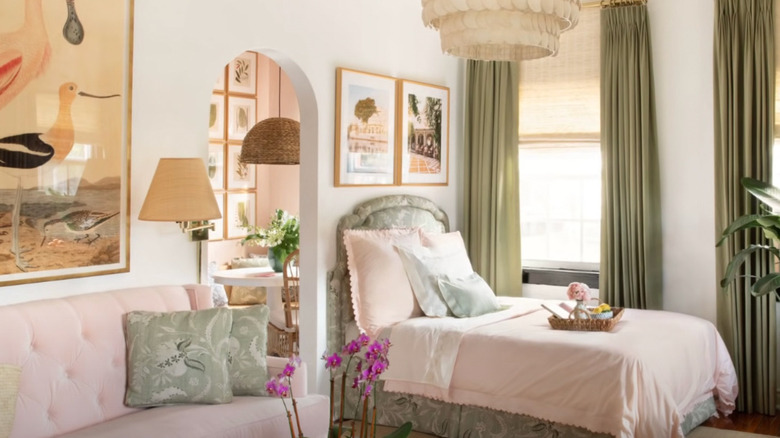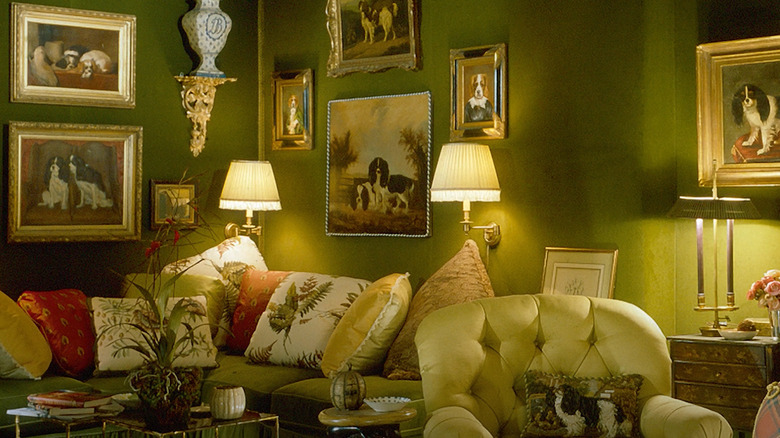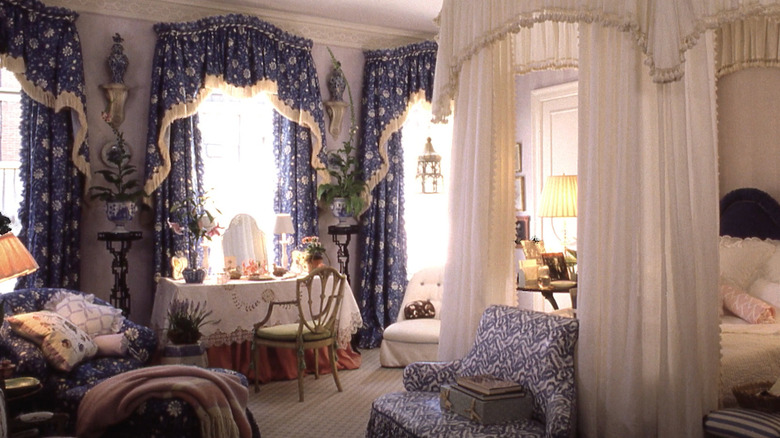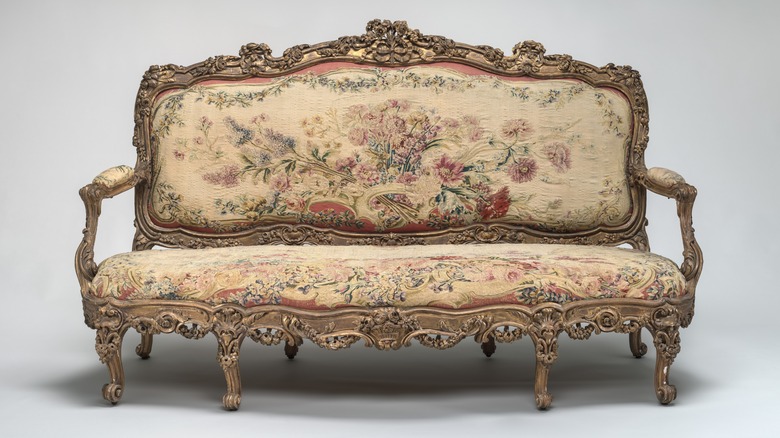What Does It Really Mean To Have Chintzy Décor?
For quite some time, minimal spaces have reigned in the world of interior design. While people still love their white and spacious rooms, a resurgence of loud and buzzing design is coming to the surface. Chintzy décor raved throughout the '80s and even into the late '90s. Veranda describes it as a collection of nature-inspired themes like flowers, vines, and birds, most commonly found in pastel palettes. You may remember large roses covering your grandmother's sofa or tiny leaves scattered along her kitchen wallpaper. It was a décor choice that shouted regency and sophistication, but the decline of this trend wasn't drastically seen until 2000 crept up.
In 1996, IKEA sponsored a campaign titled "Chuck out your Chintz," featuring women destroying this fabric and tearing it from their homes. Many saw this to be an ode to feminism as the lyrics sang about fighting suppression and how women have come a long way in areas of work and pay. Some may attribute the recent rise in chintzy décor to popular television dramas such as "The Crown" and "Bridgerton" on Netflix, two series that showcase this elegant trend in royalty settings. Or maybe it's the wave of nostalgia that washes over us when we see a similar chair to the one our grandfather sat in as he bounced us on his knee. Whatever the reason for the escalation of this trend, it is back, and it is thriving.
History of chintz
The Inside outlines the history of chintz, its fabrics originating from 16th century India. The word was derived from the Hindi word chint, which means scattered or sprinkled. These florals were made from printed or glazed cotton, giving a vibrant pigment that attracted lustful eyes. It was not until the 17th century that this décor made its way to Europe via Dutch and Portuguese traders, and it's safe to say that the continent was quite enamored. The continent saw such a demand for the product that England and France banned the import of chintz to protect domestic textile sales. This did not stop Versailles, and they continued to place the fabric on its furnishings and court fashion.
Once the Industrial Revolution hit in the 1850s, European factories could lift the ban and begin producing the fabric without the help of Indian artisans. Throughout the following century, chintz came in and out of style frequently. A surge came in 1940, and Jackie Kennedy's orange blossom room sparked the trend during the groovy decade of the '60s. Although chintz has a long history of being loved, it is the '80s craze that many remember today. From Princess Diana and Nancy Reagan to Mario Buatta and classic films like "Risky Business" and "Sixteen Candles," people couldn't get enough of these floral prints.
Chintz and grandmillennial
As you think of chintz décor and reminisce on the past, the trends grandmillennial or granny-chic may come to mind. Gabby Home attributes this ascending trend to an eclectic mix of traditional, homey pieces with modern elements. Using patterned upholstery, embellishments like ruffles and fringe, and floral prints, one will be transported to decades past while maintaining a contemporary vibe.
Chintz is a prominent feature of this retro-grandma style, found in curtains, china, wallpaper, art, and more. This curated clutter is often credited to nostalgia. During tumultuous times, people cling to what feels safe and familiar, so is it any wonder that grandmillennial began its rise to fame in 2020 when a pandemic plagued the world? Statista found that the second-hand furniture market saw an increase of more than two billion in 2020, nearly 16%. This trajectory is predicted to rise as consumers consider sustainability in their purchases and seek to eliminate carbon footprints.
How to decorate with chintz
Whether leaning towards granny-chic, royal excellence, or English country house, chintz décor will find a place in your home. Beginning with the type of chintz you want to feature will ensure that the most eye-catching pieces won't look out of place. When decorating with these bold patterns, you must surround the rest of your colors and accents around it. Once you have a good idea of which fabrics you like, the next thing to consider is which pieces you want to see hold that print. Are you looking at accent chairs, curtains, and hanging artwork? Or are you thinking of much more oversized items, such as a sofa and a loveseat?
The Green Room Interiors portrays different rooms incorporating chintz in many ways, each claiming a unique style. Every detail has a purpose, from the minor items in the room to the loudest ornamentation. Keep colors in mind for the particular arrangement you have in store. For a modern look, go with lighter tones of whites and blues, and lean toward rich and saturated colors to evoke a more vintage aesthetic.
Decluttering the chintzy look
Chintz décor is very busy, too much can look outdated and stuffy, and too little can lack charm. Understanding how you can incorporate energetic design into a room without feeling overwhelmingly messy is essential to a successful design. Mario Buatta, a famous American decorator designed for celebrities like Billy Joel, Mariah Carey, and Malcolm Forbes, was famously known for his chintzy style. The number of items he packed into a room always stood out to viewers. Buatta told Observer, "I like a place that looks lived in—magazines and books everywhere, pleasing decay, I'm kind of a hoarder. I love to have objects around me." Despite this, Buatta's spaces are beautifully crafted and never fail to make our eyes twinkle. So, how does he do it?
He describes the importance of setting the background for the stage, ensuring all the details in every nook and cranny flatter the centerpieces. Think of it like Chekhov's gun; every item must come into play in the result. Buatta highlights the importance of proportion as well. He advises that the room should have larger furniture if you have a smaller space. "You put a big canopy in the maid's room, and it looks like a grand bedroom," he said. "Also, I always say to see if your sofas are talking to your chairs. To figure out where things should go, look at your furniture after a party when all your friends have moved it around."
Where to buy chintzy décor
If these rich florals and botanical designs are the ones you want to be incorporated into your home, some excellent places to start would be your local antique stores. Every location will be different, with unique pieces you won't find elsewhere. If you still want to shop antiques but are not finding anything in your area that speaks to you, the online marketplace for vintage home furnishings, Chairish, is a fantastic resource for sourcing one-of-a-kind vintage pieces. To find brand-new items yet still have that washed-out look, try browsing brands like Pottery Barn or Crate & Barrel.
An authentic chintzy look will take time and effort to collect. It will consist of frequent stops in the same stores to see if there are new items, making time on vacation to see what eccentric pieces might be available in a new area, and maybe even checking out some estate sales along the way. Don't be afraid to think outside the box and turn your spaces into a curated collection of your preeminent passions.
